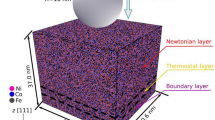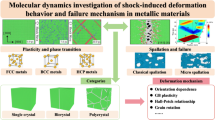Abstract
A three-dimensional Voronoi polycrystal model with 125 grains was developed for analyzing the heterogeneous phenomena and microplasticity in polycrystalline solids. Using the crystal plasticity, finite element method, the role of the load modes in the response characteristics of severe plastic deformation was investigated. Among the tested load modes, uniaxial tension and plane compression are responsible for the presence of the shear band, while pure shear leads to uniform strain distribution, and simple shear leads to the concentration of deformation. The higher shear strain was achieved by torsion, followed by simple shear. At the start-up of the sliding system, torsion and pure shear have the strongest influence, while the effects of uniaxial compression and plane compression are relatively small. After experiencing the same strain, simple shear causes lower damage than torsion. In terms of the texture, after tensile strain, polycrystalline pure aluminum shows the texture of <111>//ND, after compression, the texture type is {110}//ND, and after torsion deformation, the texture type is <111>//TD. Under small strain, plane compression includes copper texture, brass texture, and S-texture. Under high strain, the {111} <211> (annealed) texture was found in simple shear deformation. Experimental observation verified the high accuracy of the simulation results based on the excellent agreement between experiment and simulations for the stress–strain curve and texture evolution, and slip bands. Based on the principle of maximum cumulative plastic strain and minimum damage, simple shear is determined to be the optimal fine grain mode in the SPD process.













Similar content being viewed by others
References
V.M. Segal, Severe Plastic Deformation: Simple Shear Versus Pure Shear, Mater. Sci. Eng. A, 2002, 338(1–2), p 331–344.
A. Shan, I.G. Moon, H.S. Ko and J.W. Park, Direct Observation of Shear Deformation During Equal Channel Angular Pressing of Pure Aluminum, Scr. Mater., 1999, 41(4), p 353–357.
M. Furukawa, Z. Horita and T.G. Langdon, Microstructures of Aluminum and Copper Single Crystals Processed by Equal-Channel Angular Pressing, Mater. Sci. Forum, 2010, 638–642, p 1946–1951.
R. Venkatraman, S. Raghuraman and R.R. Mohan, Modeling and Analysis on Deformation Behavior for AA 6061 through Equal Channel Angular Pressing Die, Commun. Comput. Inf. Sci., 2012, 330, p 520–525.
A. Vinogradov, S. Yasuoka, S. Hashimoto, On the Effect of Deformation Mode on Fatigue: Simple Shear vs. Pure Shear, Materials Science Forum, 2008, Trans Tech Publ, p 797–802.
J. Li, F. Li, M.Z. Hussain, C. Wang and L. Wang, Micro-structural Evolution Subjected to Combined Tension-Torsion Deformation for Pure Copper, Mater. Sci. Eng. A, 2014, 610, p 181–187.
J. Li, F. Li, C. Zhao, H. Chen, X. Ma and J. Li, Experimental Study on Pure Copper Subjected to Different Severe Plastic Deformation Modes, Mater. Sci. Eng. A, 2016, 656, p 142–150.
S.H. Choi, D.H. Kim, S.S. Park and B.S. You, Simulation of Stress Concentration in Mg Alloys Using the Crystal Plasticity Finite Element Method, Acta Mater., 2010, 58(1), p 320–329.
A.K. Kanjarla, P.V. Houtte and L. Delannay, Assessment of Plastic Heterogeneity in Grain Interaction Models Using Crystal Plasticity Finite Element Method, Int. J. Plast, 2010, 26(8), p 1220–1233.
Y. Liang, S. Jiang, Y. Zhang, Y. Zhao, S. Dong and C. Zhao, Deformation Heterogeneity and Texture Evolution of NiTiFe Shape Memory Alloy Under Uniaxial Compression Based on Crystal Plasticity Finite Element Method, J. Mater. Eng. Perform., 2017, 26(6), p 2671–2682.
Y.S. Choi, M.A. Groeber, P.A. Shade, T.J. Turner, J.C. Schuren, D.M. Dimiduk, M.D. Uchic and A.D. Rollett, Crystal Plasticity Finite Element Method Simulations for a Polycrystalline Ni Micro-Specimen Deformed in Tension, Metall. Mater. Trans. A, 2014, 45(13), p 6352–6359.
D.K. Kim, J. Kim, W. Park, H.W. Lee, Y.T. Im and Y.S. Lee, Three-Dimensional Crystal Plasticity Finite Element Analysis of Microstructure and Texture Evolution During Channel Die Compression of IF Steel, Comput. Mater. Sci., 2015, 100, p 52–60.
H.K. Ji, M.G. Lee, J.H. Kang, C.S. Oh and F. Barlat, Crystal Plasticity Finite Element Analysis of Ferritic Stainless Steel for Sheet Formability Prediction, Int. J. Plast, 2017, 93, p 26–45.
O. Ozhoga-Maslovskaja, K. Naumenko, H. Altenbach and O. Prygorniev, Micromechanical Simulation of Grain Boundary Cavitation in Copper Considering Non-proportional Loading, Comput. Mater. Sci., 2015, 96, p 178–184.
P. Zhang, M. Karimpour, D. Balint, J. Lin and D. Farrugia, A Controlled Poisson Voronoi Tessellation for Grain and Cohesive Boundary Generation Applied to Crystal Plasticity Analysis, Comput. Mater. Sci., 2012, 64, p 84–89.
S.I. Liang-Ying, L.Ü. Cheng, K. Tieu and X.H. Liu, Simulation of Polycrystalline Aluminum Tensile Test with Crystal Plasticity Finite Element Method, Trans. Nonferrous Met. Soc. China, 2007, 17(6), p 1412–1416.
K.S. Zhang, D. Zhang, R. Feng and M.S. Wu, Microdamage in Polycrystalline Ceramics Under Dynamic Compression and Tension, J. Appl. Phys., 2005, 98(2), p 79.
J. Alcalá, O. Casals and J. Očenášek, Micromechanics of Pyramidal Indentation in fcc Metals: Single Crystal Plasticity Finite Element Analysis, J. Mech. Phys. Solids, 2008, 56(11), p 3277–3303.
P.T. Wei, C. Lu, K. Tieu, G.Y. Deng and J. Zhang, Modelling of Texture Evolution in High Pressure Torsion by Crystal Plasticity Finite Element Method, Appl. Mech. Mater., 2015, 764–765, p 56–60.
K. Zhang, B. Holmedal, O.S. Hopperstad, S. Dumoulin, J. Gawad, A. Van Bael and P. Van Houtte, Multi-level Modelling of Mechanical Anisotropy of Commercial Pure Aluminium Plate: Crystal Plasticity Models, Advanced Yield Functions and Parameter Identification, Int. J. Plast., 2015, 66, p 3–30.
L.Y. Si, C. Lu, N.N. Huynh, A.K. Tieu and X.H. Liu, Simulation of Rolling Behaviour of Cubic Oriented al Single Crystal with Crystal Plasticity FEM, J. Mater. Process. Technol., 2008, 201(1–3), p 79–84.
H. Ritz, P. Dawson and T. Marin, Analyzing the Orientation Dependence of Stresses in Polycrystals Using Vertices of the Single Crystal Yield Surface and Crystallographic Fibers of Orientation Space, J. Mech. Phys. Solids, 2010, 58(1), p 54–72.
D. Raabe and F. Roters, Using Texture Components in Crystal Plasticity Finite Element Simulations, Int. J. Plast., 2004, 20(3), p 339–361.
H. Li, A. Oechsner, D. Wei, G. Ni and Z. Jiang, Crystal Plasticity Finite Element Modelling of the Effect of Friction on Surface Asperity Flattening in Cold Uniaxial Planar Compression, Appl. Surf. Sci., 2015, 359(30), p 236–244.
C. Wang, F. Li, L. Wei, Y. Yang and J. Dong, Experimental Microindentation of Pure Copper Subjected to Severe Plastic Deformation by Combined Tension-Torsion, Mater. Ence Eng. A, 2013, 571(1), p 95–102.
J. Cao, F. Li, X. Ma and Z. Sun, A Modified Elliptical Fracture Criterion to Predict Fracture Forming Limit Diagrams for Sheet Metals, J. Mater. Process. Technol., 2018, 252, p 116–127.
J. Cao, F. Li, Z. Sun and X. Ma, Study of Fracture Behavior for Anisotropic 7050–T7451 High-Strength Aluminum Alloy Plate, Int. J. Mech. Sci., 2017, 128, p 445–458.
H.F. Alharbi and S.R. Kalidindi, Crystal Plasticity Finite Element Simulations Using a Database of Discrete Fourier Transforms, Int. J. Plast., 2015, 66, p 71–84.
O. Diard, S. Leclercq, G. Rousselier and G. Cailletaud, Evaluation of Finite Element Based Analysis of 3D Multicrystalline Aggregates Plasticity: Application to Crystal Plasticity Model Identification and the Study of Stress and Strain Fields Near Grain Boundaries, Int. J. Plast., 2005, 21(4), p 691–722.
U. Borg, A Strain Gradient Crystal Plasticity Analysis of Grain Size Effects in Polycrystals, Eur. J. Mech. A Solids, 2007, 26(2), p 313–324.
G. Venkatramani, S. Ghosh and M. Mills, A Size-Dependent Crystal Plasticity Finite-Element Model for Creep and Load Shedding in Polycrystalline Titanium Alloys, Acta Mater., 2007, 55(11), p 3971–3986.
X. Lu, X. Zhang, M. Shi, F. Roters, G. Kang and D. Raabe, Dislocation Mechanism Based Size-Dependent Crystal Plasticity Modeling and Simulation of Gradient Nano-grained Copper, Int. J. Plast., 2019, 113(2), p 52–73.
Acknowledgments
The authors would like to express their sincere thanks for the research grants provided by the National Natural Science Foundation of China (Grant No. 51805002) and by the Research Fund of Key Laboratory of Advanced Metal Material Green Preparation and Surface Technology (AHUT), Ministry of Education, China (Grant No. GFST2020KF03).
Author information
Authors and Affiliations
Corresponding author
Additional information
Publisher's Note
Springer Nature remains neutral with regard to jurisdictional claims in published maps and institutional affiliations.
Rights and permissions
About this article
Cite this article
Li, J., Yu, R., Chen, J. et al. Influence of Load Modes on the Characteristics of Severe Plastic Deformation Based on Crystal Plasticity Finite Element Method. J. of Materi Eng and Perform 30, 1981–1993 (2021). https://doi.org/10.1007/s11665-021-05501-0
Received:
Revised:
Accepted:
Published:
Issue Date:
DOI: https://doi.org/10.1007/s11665-021-05501-0




